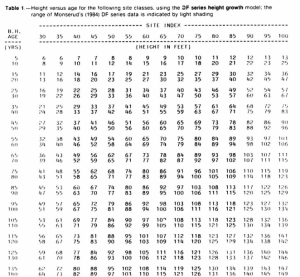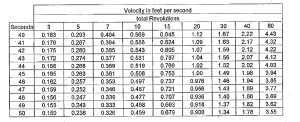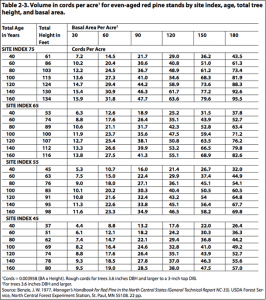5.2 Interpolating in Tables Where Numbers Remain Positive
Applications
In section 5.1, we discussed how interpolation works for forestry stand tables. Other tables we might use interpolation for include volume tables, taper tables, site index tables, and more. The arithmetic for each of these tables is similar, once we become comfortable reading the table.

We can use the same approach to interpolation for a variety of tables. As in most things, practice will get us closer to perfect!
Examples: Interpolation on More Interesting Tables
A) Base the following interpolations off of this table of showing the growth of Arctic Char at different temperatures.
- What is the specific growth rate (SGR) for a 20 gram char in water of 6°C?
- What is the specific growth rate (SGR) for a 37 gram char in water of 6°C?
- What is the specific growth rate (SGR) for a 130 gram char in water of 6°C?
- What is the specific growth rate (SGR) for a 20 gram char in water of 7.2°C?
- What is the specific growth rate (SGR) for a 100 gram char in water of 4.8°C?
B) Base the following interpolations off of Table 1 in the excellent publication SECOND-GROWTH YIELD, STAND, AND VOLUME TABLES FOR THE WESTERN WHITE PINE TYPE
- What is the average height of the dominant overstory when a stand on a poor site is 60 years old? What is the average overstory height on an excellent site at the same stand age?
- What is the average height of the dominant overstory when a stand on a poor site is 75 years old? What is the average overstory height on an excellent site at the same stand age?
- What is the basal area of trees greater than 0.6 inches on a poor site at 105 years? What is the basal area of trees greater than 0.6 inches on an excellent site at 105 years?
As you continue to set up proportions to interpolate, you may see that you can solve straightforward situations using what I'm calling the "rate of change" method. Let's examine what that looks like using this table for white spruce and black spruce (Picea glauca & Picea mariana) growth in Alaska.
Spruce stand table for Susitna River Basin, AK
First, use a proportion to find the board foot volume for a tree with a DBH of 20" and a height of 72'.
Now - let's try this using the rate of change method.
1. Find the change per unit for the cells you are interpolating between. At a DBH of 20" how many board feet of volume does a tree put on for every foot of height it gains? Find the difference between the volume at 75' and the volume at 70'. Divide this by 5 to get the change in volume per foot added to height.
[latex]\frac{358.9-328.9}{5}= 6[/latex]
So, a tree gains 6 board feet of volume for every foot of height it puts on at 20" dbh.
2. Determine how many units your value is away from the known cell value. How many feet are we adding to the height that we already have a cell value for? In this case we know the volume for a 70' tree and we are dealing with a 72' tree.
[latex]72-70=2[/latex]
In this example, we are adding 2' to the known value.
3. Multiply the change per unit by the number of units your value is away from a known cell value.
[latex]2*6=12[/latex]
This gives us the additional board feet of volume that a tree of 72' will have over a tree of 70'.
4. Add the product of the change per unit and the number of units difference to the base cell value.
[latex]328.9+12=340.9[/latex]
This will be the same answer you got when you used proportions. We just arrived a different way!
Use whichever method is faster for you as we move forward in this chapter. Note that when we get into tables with negative numbers, students are more likely to make mistakes using the rate of change method.
Examples: More Interpolation...
A) Use the table for white and black spruce volume to find the following:
- What is the volume at 13.5" dbh and 35' height?
- What is the volume at 24" dbh and 78' height?
- What is the volume at 26" dbh and 83' height?
B) Use the table showing the stream velocity in feet per second (in each cell) as a function of the number of seconds and the number of revolutions of a stream gauge wheel for the next few interpolations.
- What is the stream velocity if you see 7 revolutions in 45 seconds?
- What is the stream velocity if you see 9 revolutions in 45 seconds?
- What is the stream velocity if you see 22 revolutions in 40 seconds?

Problem Set 5.2
Use the following volume table for the interpolations below.
 Find the cords per acre in the following scenarios.
Find the cords per acre in the following scenarios.
1. Site Index 75 Age 80 Basal Area Per Acre 120
2. Site Index 75 Age 110 Basal Area Per Acre 120
3. Site Index 55 Age 80 Basal Area Per Acre 135
4. Site Index 55 Age 125 Basal Area Per Acre 120
5. Site Index 45 Age 130 Basal Area Per Acre 150

